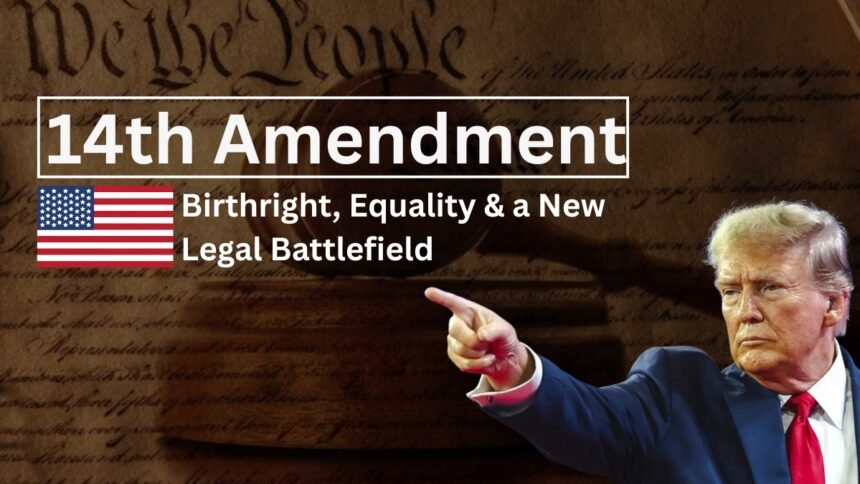Introduction: Why This Matters Now
14th Amendment : On June 27, 2025, a landmark Supreme Court decision shook the very core of U.S. immigration law. In a 6–3 ruling in Trump v. CASA, the U.S. Supreme Court (SCOTUS) restricted the ability of federal courts to issue universal (nationwide) injunctions, impacting President Trump’s executive order aimed at eliminating automatic birthright citizenship under the 14th Amendment.
Despite not judging the executive order’s constitutionality, this action dramatically reshapes the legal terrain potentially allowing the order to take effect in many states. This article covers everything from birthright citizenship meaning to the key legal players including Ketanji Brown Jackson and Amy Coney Barrett and explains why millions are paying attention.
READ MORE :- All Planes Will Head Home”: Trump Declares Ceasefire in Israel-Iran War Amid Missile Chaos
2. Birthright Citizenship: What’s the 14th Amendment?
The Citizenship Clause of the Fourteenth Amendment (ratified 1868) declares:
“All persons born or naturalized in the United States, and subject to the jurisdiction thereof, are citizens of the United States…”
This grants jus soli citizenship by birth on U.S. soil regardless of parents’ immigration status. Its roots trace back to the Civil War and the 1866 Civil Rights Act. A cornerstone case is United States v. Wong Kim Ark (1898), which affirmed that children born in the U.S. to non‑citizen parents still qualify as citizens .
3. Trump’s Push Against Birthright Citizenship
President Trump’s Executive Order 14160 (Jan 20, 2025) sought to revoke automatic birthright citizenship for children born to undocumented or temporary-resident parents . States and legal groups immediately responded, obtaining nationwide injunctions blocking its implementation. Lawsuits like Washington v. Trump and Barbara v. Trump contested its constitutionality .
4. Trump v. CASA (No. 24A884)
In rapid emergency appeals, SCOTUS consolidated cases to consider whether lower courts exceeded authority by issuing universal injunctions. The Court did not rule on whether the executive order itself was valid , focusing strictly on the scope of injunctive relief.
Key holdings:
- Federal courts likely lack authority under the Judiciary Act to issue nationwide injunctions unless necessary to fully protect the plaintiff.
- Universal relief exceeds judicial authority.
- Partial stay granted; injunctions now only apply to named plaintiffs .
5. What Justices Said & the Split Decision
- Majority (6‑3) led by Justice Amy Coney Barrett, joined by Roberts, Thomas, Alito, Gorsuch, and Kavanaugh.
- Concurrences from Thomas, Alito, Kavanaugh reaffirmed historical limits on universal injunctions .
Liberal dissent, written by Justice Sonia Sotomayor, with Jackson and Kagan joining:
“No right is safe… the court gives way.”
Warning that limiting universal injunctions could permit unconstitutional policies to take root .
Justice Ketanji Brown Jackson joined the dissent, sharply criticizing the majority and highlighting the fragility of constitutional safeguards .
6. Nationwide Injunctions: What They Are & Why They Matter
A nationwide injunction halts enforcement of a policy across the entire U.S., not just for the parties involved. In Trump v. CASA, SCOTUS ruled this power exceeded what Congress intended under the Judiciary Act of 1789 .
Impact:
- Courts can now issue targeted injunctions, affecting only named plaintiffs.
- This creates a patchwork legal landscape—where policies may apply in some states but not others .
Crucially, the Court left class-action lawsuits and more limited injunctions intact .
7. Birthright Citizenship’s Legal Future
SCOTUS avoided a direct ruling on the 14th Amendment claim, meaning birthright citizenship remains law—for now. However, the ruling enables the executive order to eventually take effect in states without their own injunctions after July 27, 2025 (30 days post‑ruling) .
States like Maryland and Washington may still block it locally. Others may see the rule enforced, raising concerns about stateless children and complex regional legal disparities .
8. Supreme Court Today: Major Rulings at a Glance
Beyond the CASA ruling, SCOTUS issued critical decisions on:
- U.S. radiation regulations for schools
- Age verification for porn websites
- Federal funding for LGBTQ+ content
All reinforcing judicial limits on lower court power and expanding executive sway .
9. Why This Matters to You
- Immigration families: Some U.S. born children could be denied citizenship, depending on jurisdiction.
- For legal precedent: The universal injunction doctrine has narrowed dramatically.
- Executive power: This strengthens presidential authority against judicial blockades.
- Civil rights: Dissenters warn this trend undermines constitutional protections, potentially affecting future legislation on guns, abortion, voting, etc.
10. Unanswered Questions / What’s Next
- Will SCOTUS later decide on the 14th Amendment constitutionality of EO 14160?
- Will states or civil organizations succeed with class-action injunctions to restore universal relief?
- Do lower courts now have final word on who remains blocked?
- How will this decision influence judicial interpretation of other executive actions?
11. Quick Glossary
| Term | Meaning |
|---|---|
| 14th Amendment | Constitutional clause guaranteeing citizenship to those born in the U.S. |
| Birthright citizenship | Legal right that children born on U.S. soil are American citizens |
| SCOTUS | Supreme Court of the United States |
| Universal injunction | Court order blocking policy nationally, not just for parties |
| Nationwide injunction | Similar to universal injunction |
| Trump v. CASA | SCOTUS case limiting injunction scope but not ruling on EO’s legality |
| Ketanji Brown Jackson | Associate Justice, dissented with Sotomayor & Kagan |
| Amy Coney Barrett | Conservative Justice, wrote key majority opinion |
| Justice Jackson | Joined liberal dissent warning of precedent danger |
| Justice Sotomayor | Authored sharp dissent—”No right is safe” |
| Executive Order 14160 | Trump’s directive to revoke birthright citizenship |
12. Conclusion
The Supreme Court’s June 2025 rulings have profoundly altered America’s legal landscape:
- A bold limitation on universal injunctions
- A divided Court (6–3), split along ideological lines
- A pathway for Trump’s birthright citizenship policy to gain partial legal traction
- A looming legal patchwork across different U.S. states
- A major blow to judicial oversight in exchange for expanded executive power
At its core, this is a battle over the balance of power between Congress, judiciary, and the President—and the legal fate of countless U.S.-born children hangs in the balance.


















